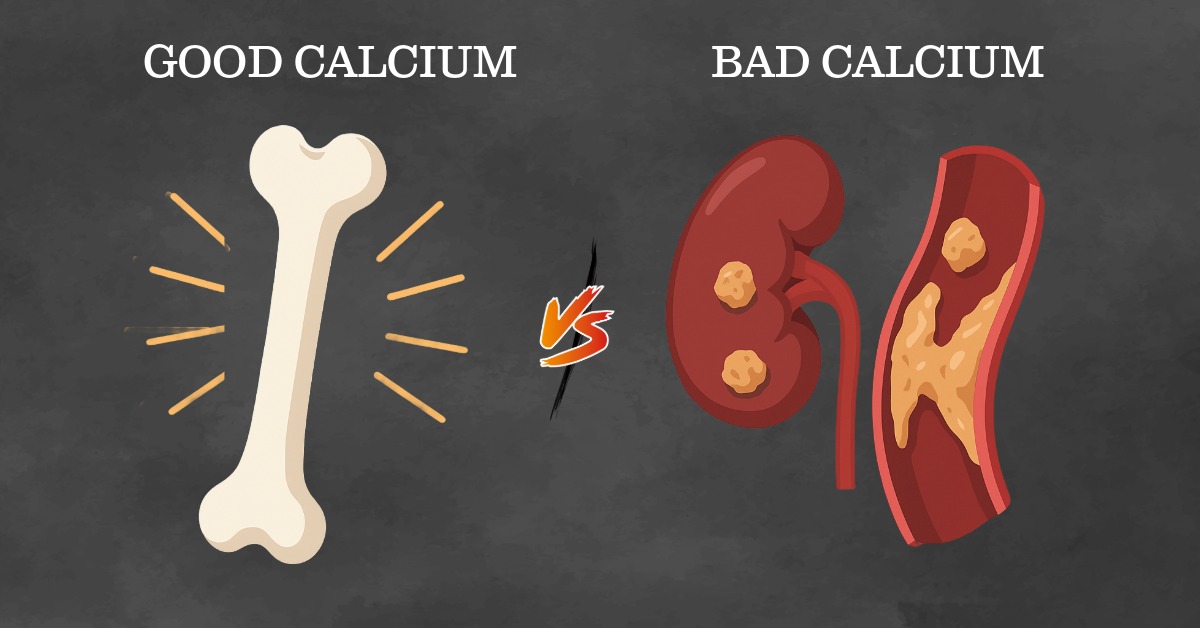The Double-Edged Sword of Calcium
“We’ve all heard that calcium builds strong bones—but what happens when you get too much of a good thing?”
For decades, calcium has been celebrated as the cornerstone of bone strength and joint health. From childhood through old age, doctors, teachers, and even cereal commercials remind us to “drink milk for strong bones.” And they’re not wrong—calcium is absolutely essential for preventing osteoporosis, maintaining skeletal integrity, and supporting everyday mobility.
But here’s the twist: while too little calcium weakens bones, too much calcium can also harm the body in surprising ways. Kidney stones, cardiovascular complications, and digestive discomfort are only some of the risks tied to excess intake.
This raises an important question: How much calcium is enough, and when does it become too much?
In this article, we’ll explore the real role of calcium in bone health, how much your body truly needs, the dangers of over-supplementation, and practical strategies for keeping bones and joints strong without tipping into overload.
Why Calcium Is Essential for Bone Health
Calcium is the most abundant mineral in the body, and nearly 99% of it resides in the bones and teeth. But its role goes far beyond just skeletal strength.
- Bone density: Calcium is the structural backbone of bone tissue, making it vital for preventing fractures and osteoporosis.
- Muscle function: Without calcium, muscles can’t contract properly—including the heart muscle.
- Nerve signaling: Calcium ions allow nerves to send messages throughout the body, powering reflexes and coordination.
Think of bones as a calcium bank account. When dietary calcium runs low, the body “withdraws” calcium from bones to keep critical processes like muscle contraction and nerve function running smoothly. Over time, those withdrawals weaken bone density.
This is why consistent calcium intake is key to avoiding bone-related conditions, particularly as we age.
Suggested visual: Infographic “The Role of Calcium in the Body.”
How Much Calcium Do You Really Need?
The body’s calcium requirements vary depending on age and gender. According to nutrition guidelines:
- Adults 19–50 years: 1,000 mg/day
- Women 51+ and Men 71+: 1,200 mg/day
- Teenagers (14–18 years): 1,300 mg/day
While supplements are widely available, most experts agree that whole food sources are best. Dairy products, leafy greens, almonds, and fortified plant-based milks all contribute to daily intake.
But here’s the critical part: calcium doesn’t work alone. Its absorption depends on other nutrients like:
- Vitamin D: Helps the body absorb calcium.
- Magnesium: Works with calcium to support muscles and nerves.
- Vitamin K2: Directs calcium into bones rather than arteries.
This means that even if you hit your calcium intake recommendations, poor nutrient balance can limit the benefits—or even create risks.
Suggested visual: Chart of calcium needs by age group.
The Risks of Too Much Calcium
It’s tempting to think “more is better” when it comes to bone health. But taking high-dose calcium supplements or consuming large amounts through diet can backfire.
Potential risks of excess calcium include:
- Kidney stones: Excess calcium can combine with oxalates to form painful stones.
- Vascular calcification: Too much calcium in the bloodstream may harden arteries, increasing heart disease risk.
- Digestive issues: Constipation, nausea, and abdominal pain are common too much calcium side effects.
- The “Calcium Paradox”: Without supporting nutrients like vitamin D and K2, calcium may not strengthen bones, instead accumulating in soft tissues.
For most adults, consuming over 2,000–2,500 mg/day raises the risk of these side effects. This is why balance—not overload—is key.
Suggested visual: Side-by-side chart “Healthy Calcium Levels vs. Excessive Calcium.”
Spotting the Signs of Calcium Overload
Unlike deficiencies, calcium overload doesn’t always scream its presence. But the body often gives subtle warnings:
- Constipation or digestive discomfort
- Frequent urination and dehydration
- Confusion, brain fog, or fatigue
- Kidney pain or stones
- Heart palpitations in severe cases
Anecdote: Consider “Mark,” a 58-year-old who started taking high-dose calcium supplements to protect against osteoporosis. He believed more calcium would guarantee stronger bones. Instead, he developed kidney stones and constant fatigue—classic calcium overdose symptoms. Once he adjusted his intake and added vitamin D and magnesium, his symptoms eased.
If you suspect excess calcium, consult a doctor. A simple blood test can reveal imbalances.
Suggested visual: Checklist graphic “Warning Signs of Too Much Calcium.”
Smarter Strategies for Bone & Joint Health
The key to bone and joint strength isn’t consuming mountains of calcium—it’s creating balance.
Here’s how to do it smartly:
- Prioritize whole foods: Dairy, leafy greens, nuts, seeds, and fortified foods offer calcium in bioavailable forms.
- Support absorption: Pair calcium with vitamin D, magnesium, and vitamin K2 for maximum benefit.
- Move your body: Weight-bearing exercise like walking, running, or resistance training stimulates bone density.
- Mind supplementation: Use supplements to fill gaps, not as a replacement for food.
And while calcium is critical for bone structure, joint health deserves attention too. For those concerned about mobility and joint comfort, ArthroFlex from Health Spark offers targeted joint health support as part of a balanced routine. Combining joint support with bone care creates a holistic foundation for lifelong mobility.
Suggested visual: Infographic “Top 5 Ways to Strengthen Bones Naturally.”
Who Needs to Be Extra Careful With Calcium?
While most people benefit from mindful calcium intake, certain groups face a higher risk of overdoing it:
- Older adults: Often rely heavily on supplements without monitoring total intake.
- People with kidney disease: Reduced kidney function makes it harder to clear excess calcium.
- Those with heart conditions: Excess calcium may increase vascular risks.
- Postmenopausal women: While at higher risk of osteoporosis, they are also more vulnerable to calcium imbalance.
For these groups, personalized guidance from healthcare providers is essential.
Suggested visual: Checklist graphic “High-Risk Groups for Calcium Overload.”
Conclusion: Balance Is the Key to Strong Bones and Healthy Joints
Calcium is undeniably crucial for strong bones, healthy joints, and overall wellness. But more is not always better. Too much calcium can lead to kidney stones, heart complications, and digestive issues—making balance the ultimate goal.
The good news? With a nutrient-rich diet, mindful supplementation, and active living, most people can achieve optimal bone strength without risking overload.
“Don’t just add calcium—focus on balance, movement, and overall joint health to stay strong for years to come.”
Thought-Provoking Closing
“The real question isn’t how much calcium you can take—it’s whether you’re giving your bones and joints the balanced care they deserve.”


